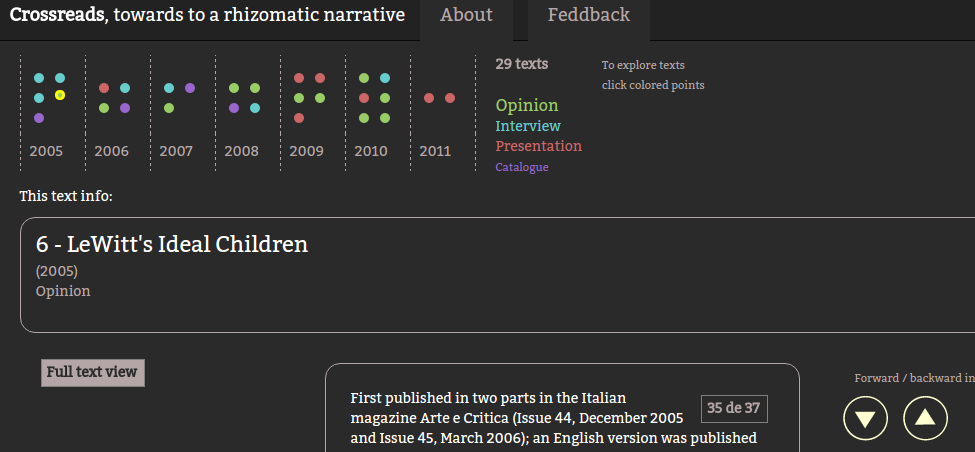Data visualization: Crossreads (v2), Domenica Quaranta “In your computer”
Crossreads I, exhibition of texts site
Text represented: “In Your Computer”, by Domenico Quaranta (2011)
NOTE: this demo of Crossreads II is in English. Visit version I for a demo in Catalan & Spanish.
This project was presented as a poster in the Workshop “The search is over”, part of the Conference Digital Libraries 2014, London (University College London).
ABOUT CROSSREADS:
Inspired by works such as Rhizome we present an ongoing project in the domain of information seeking and discovery called Crossreads. This project proposes an experimental way of reading texts, as an alternative to traditional linear reading. I proposes to break the initial narrative line of a text by segmenting it into smaller parts. Then, the text is reordered according to similarity scores, which finally offers the reader multiple paths to read the text. The aim of this project is to explore and study the effects when a reader processes fragmented information, as well as to analyze user activity and support reader’s exploration with visualization techniques: the interaction text-reader, the text as a collec- tion of segments, the most popular reading paths, and so on. At this stage of the project we cannot tell accurately what the benefits of the crossreading are unclear. However In the following sections, we discuss related work and influ- ences. Then, we present the experiments done so far. Fi- nally, we present some conclusions and directions for future work.
ABOUT THE TEXT:
The text “In Your Computer”, by Domenico Quaranta (2011)
This book is a collection of texts written by Domenico Quaranta between 2005 and 2010 for exhibition catalogues, printed magazines and online reviews: a pocket version of what the author would save from the universal flood, in a world without computers. Most of the fields of research he has developed are represented: from Net Art to Software Art and videogames, from biotechnologies to the debate around curating and the positioning of New Media Art in the contemporary landscape, and back to Net Art again. (this is an excerpt from the Introduction)
The book is divided in 29 texts, including acknowledgments and introduction.
